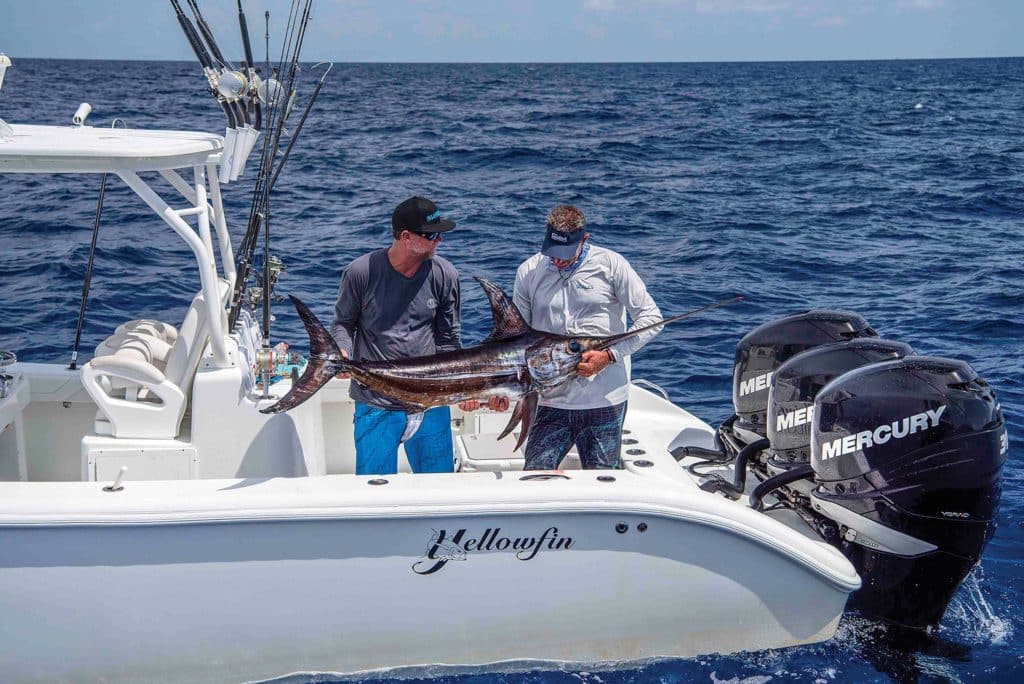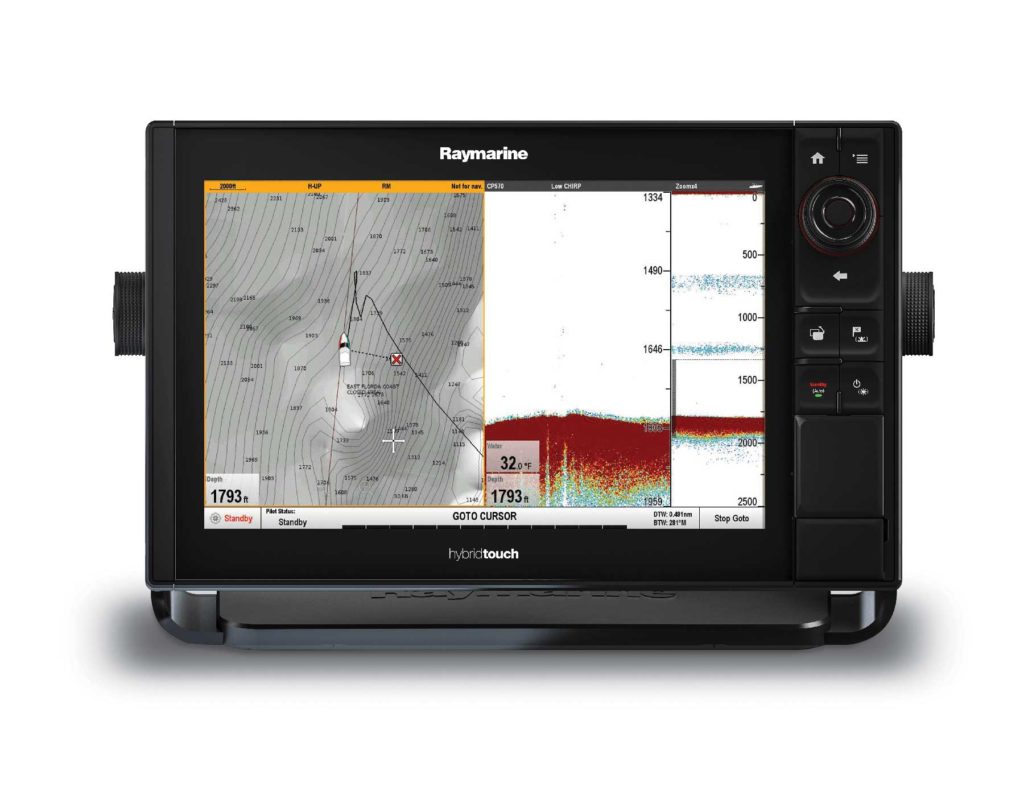
With a bait set 1,565 feet deep for swordfish, Capt. Jack Carlson of Two Conchs charters was just 30 minutes into his first morning drift in the Atlantic waters off Marathon, Florida, when he noticed a bright red, elongated mark on the screen of his Furuno TZtouch3 multifunction display.
To his trained eyes, his high-power chirp depth sounder had picked up the unmistakable mark of a swordfish. Seconds later, the rod tip twitched and then sprang upward, indicating the sword had eaten the bait and was rocketing upward with the heavy sinker in tow. Carlson and his crew were hooked up. Forty minutes later, the swordfish they had spotted on the screen—a 120-pounder—came aboard amid hoots and high-fives.
Pierce the Abyss
Even veteran anglers like Carlson marvel at the strange world hundreds of feet below the ocean surface, a place where sunlight disappears, water temperatures plummet, and some of the planet’s most bizarre and prized fish swim.
This biosphere is becoming more familiar as daytime swordfishing and deep-dropping increase in popularity and sophistication. Much credit for the growth in knowledge goes to advancements in high-power chirp technology. These depth sounders can now reach deep and return remarkably detailed images of this realm. Here are tips for selecting and using such systems.
More Power
To effectively read the ocean floor and marine life at depths of 1,000 to 2,000 feet or more, you need at least 2 kilowatts of power, if not greater, says Eric Kunz, senior product manager for Furuno USA. “For every 20 to 25 percent increase in depth penetration, you need to increase the power twofold,” he explains. That’s why you need as much power as you can obtain.
MFDs alone don’t typically provide that kind of output. Most max out at 1 kW. That won’t cut it when you’re going deep, so you need to network the MFD with a separate module to boost power.
“With the TZtouch3 chirp depth sounder, for example, you can add the new Deep Impact DI-FFAMP to amplify power all the way up to 3 kW,” Kunz says.

Other major brands also have boosters. Garmin offers the GSD26 for its GPSMap series, and Simrad has the S5100 for its MFDs, both capable of increasing power up to 3 kW. Raymarine offers the CP470 (2 kW) and CP570 (3 kW) for its Axiom series.
Low and Large
The next part of the equation is using a transducer that will accept this additional power and offer low-frequency chirp capability. Like the subwoofer of an audio system that booms through walls, high-power, lower-frequency chirp transducers can boom through deep water.
Such transducers run on the large side because they need element arrays with greater surface area to transmit and receive the potent signals. To give you an idea, Airmar Technology’s PM599LH measures 14.5 inches long by 6.13 inches wide by 4.87 inches tall—roughly the shape and size of a loaf of bread—but it weighs more than 30 pounds. Its low-frequency channel chirps across a frequency band of 20 to 60 kHz.
Mounting Options
Such transducers usually flush-mount into a pocket on a keel pad near the back of an offshore V-hull, or on step-hulls, forward of the leading step to minimize aeration across the transducer face.
Pocket mounting a transducer of this size is often reserved for new, custom fishing boats of 32 feet in length or more while under construction. So, think about this and discuss options with your boatbuilder when you order your boat.
Retrofitting existing boats can be a time-consuming and expensive undertaking. But it’s not impossible, and there are alternatives, says Jim McGowan, marketing manager for Raymarine.
“On boats where pocket mounting isn’t feasible, a shoot-through-style chirp transducer such as the R599LW (offered by both Airmar and Raymarine) can be housed in the hull,” McGowan explains. “It offers the same power and frequencies as the PM599LH, but the installation is simpler.” The transducer transmits and receives its signals through the fiberglass with minimal loss of sensitivity when properly mounted.
Zoom In
A fish finder’s zoom function plays an especially important role when daytime swordfishing or deep-dropping, says David Dunn, director of sales and marketing for Garmin. “Zoom lets you focus on a certain part of the water column that interests you the most,” he explains.
“Let’s say you only care about looking for swordfish and bait in 700 to 1,100 feet,” Dunn says. “Use the zoom to expand that range to full screen, and it will magnify targets so you can see them much better than if you were looking at the entire water column.”
Carlson likes to use the zoom function when deep-dropping for species such as golden tilefish, queen snapper and snowy grouper. “I use bottom zoom on my Furuno TZtouch3 to zero in and get more details on fish and bait hanging around ledges,” he says.
Full Auto
Dialing in the gain to effectively read bottom and fish at great depths is much easier with the newest sounders than it might have been with old-school machines. That’s because the automatic-gain settings have been meticulously refined by the manufacturers. “The algorithms for the auto gain on the Axiom series is very good,” McGowan says. “You really don’t have to play with it much at all.”
Kunz echoes that. “Out-of-the-box auto settings on the Furuno TZtouch3 are designed to be easy to use,” he says. “We worked hard to make them that way because most guys don’t have the time to play around with gain. They just want to find and catch fish.”









